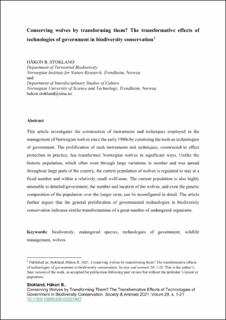| dc.contributor.author | Stokland, Håkon B. | |
| dc.date.accessioned | 2021-11-11T08:59:23Z | |
| dc.date.available | 2021-11-11T08:59:23Z | |
| dc.date.created | 2021-11-10T11:50:03Z | |
| dc.date.issued | 2021 | |
| dc.identifier.citation | Society & Animals. 2021, 29 1-21. | en_US |
| dc.identifier.issn | 1063-1119 | |
| dc.identifier.uri | https://hdl.handle.net/11250/2829023 | |
| dc.description.abstract | This article investigates the construction of instruments and techniques employed in the management of Norwegian wolves since the early 1980s by construing the tools as technologies of government. The proliferation of such instruments and techniques, constructed to effect protection in practice, has transformed Norwegian wolves in significant ways. Unlike the historic population, which often went through large variations in numbers and was spread throughout large parts of the country, the current population of wolves is regulated to stay at a fixed number and within a relatively small wolf-zone. The current population is also highly amenable to detailed government; the number and location of the wolves, and even the genetic composition of the population over the longer term, can be reconfigured in detail. The article further argues that the general proliferation of governmental technologies in biodiversity conservation has meant similar transformations of a great number of endangered organisms. biodiversity – endangered species – technologies of government – wildlife management – wolves | en_US |
| dc.language.iso | eng | en_US |
| dc.publisher | Brill | en_US |
| dc.title | Conserving Wolves by Transforming Them? The Transformative Effects of Technologies of Government in Biodiversity Conservation | en_US |
| dc.type | Peer reviewed | en_US |
| dc.type | Journal article | en_US |
| dc.description.version | acceptedVersion | en_US |
| dc.rights.holder | This is the authors' manuscript to an article published by Brill. | en_US |
| dc.subject.nsi | VDP::Zoologiske og botaniske fag: 480 | en_US |
| dc.subject.nsi | VDP::Zoology and botany: 480 | en_US |
| dc.source.pagenumber | 1-21 | en_US |
| dc.source.volume | 29 | en_US |
| dc.source.journal | Society & Animals | en_US |
| dc.identifier.doi | 10.1163/15685306-00001407 | |
| dc.identifier.cristin | 1953135 | |
| dc.relation.project | Egen institusjon: NTNU, Det humanististiske fakultet | en_US |
| cristin.ispublished | true | |
| cristin.fulltext | postprint | |
| cristin.qualitycode | 1 | |
